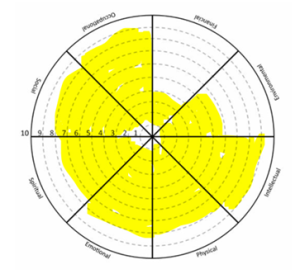TL;DR:
- It may be difficult to keep up the energy that inspired us at the beginning of the new year for our resolutions.
- Consider using the Wellness Wheel. It is a great visual tool to assess 8 dimensions of wellness.
- The goal is to discover which parts are active and which parts need more focused attention.
- Let’s check in on our wellness so we can live a life of contentment, fulfillment, and happiness.
Raise your hand if you made a New Year’s Resolution to increase your contentment, fulfillment, and ultimately, happiness.
Keep your hand up if you are still well on your way to accomplishing that goal.
I sense some hands just went down (mine included). Now that the newness and freshness of the new year have dwindled a bit, it’s sometimes difficult to keep our energy focused on what inspired us a month ago.
Taking a few moments for reflective thinking accomplishes two things: it incorporates a little bit of stillness in your day and allows you to do something you rarely get to do as a busy teacher–focus on yourself. Share on XThe Wellness Wheel
To help us recapture some of that focus, we can consider using a great tool, the Wellness Wheel. There are many versions of the Wellness Wheel, but it originally comes from Dr. Bill Hettler. Essentially, he outlined 8 dimensions of wellness.
Here is a quick overview of each section:
- Physical – movement, nutrition, rest
- Emotional – feelings, coping
- Intellectual – learn new things/apply in a different way
- Spiritual – connection to the universe
- Social – connection to others/feeling supported
- Environmental – impacting our homes, communities, planet
- Occupational – fulfillment from our job
- Financial – making decisions about money
The goal is to figure out which parts of the Wellness Wheel are present and active in your life, and which parts deserve a bit more focused attention.
The way you do this is to color in the wheel according to this scale:
10: Exceeding expectations
8-9: Great!
5-7: Satisfactory
1-4: Needs Improvement
You can take the formal assessment here or you can take a few minutes to do some generalized reflective thinking. Taking a few moments for reflective thinking accomplishes two things: it incorporates a little bit of stillness in your day and allows you to do something you rarely get to do as a busy teacher—focus on yourself.
[scroll down to keep reading]What Is Your Next Right Thing?
Let’s consider each section of the Wellness Wheel. Think about where you would be in each section and more importantly, where you want to be. When I complete my own Wellness Wheel, this is what I see:
 This exercise helps me discern my next right thing. It shows that I am doing well at creating and honoring boundaries that provide time and space for social connection, physical wellness, and creative work. AND it shows areas that are lacking and could benefit from some boundaries.
This exercise helps me discern my next right thing. It shows that I am doing well at creating and honoring boundaries that provide time and space for social connection, physical wellness, and creative work. AND it shows areas that are lacking and could benefit from some boundaries.
After this exercise, it’s pretty clear that my next right thing is to better understand some things financially in my personal and professional life and re-engage in some tasks that improve the physical environment of my home, workspace, or community. My focus has become a bit clearer.
Any social, physical, or emotional New Year’s resolutions we made are put in place to strengthen our focus, happiness, and success. But routine days are filled with lots of routine things and it’s easy to lose sight of the promises we made to ourselves on January 1st.
Our days move quickly. The wheels continue to spin. Let’s slow down just a tiny bit to check in on our wellness so we can keep moving toward a direction of contentment, fulfillment, and ultimately, happiness.
Wheels up 😊
 Small Shifts. BIG gifts!
Small Shifts. BIG gifts!
Give it a try! Complete your own Wellness Wheel using the template and scale above and see if that helps you refocus on what could help you feel more content, aligned, and balanced.
About Suzanne Dailey
Suzanne Dailey is a proud member of the Teach Better Family! She is an instructional coach in the Central Bucks School District where she has the honor and joy of working with elementary teachers and students in 15 buildings. Suzanne is Nationally Board Certified, a Fellow of the National Writing Project, and has a master’s degree in Reading. She is dedicated to nurturing and developing the whole child and teacher. Suzanne lives in Doylestown, Pennsylvania with her husband and two children.




